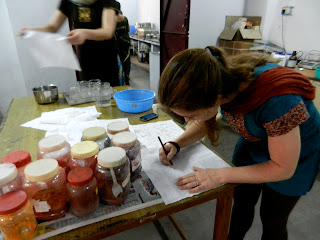Though our visit to Chennai was last week, our students are
still singing (and dancing to) “Chennai
City Indian Ocean !). There’s plenty to cover, but
hopefully this post will do our weekend in Chennai some justice:
After a quick rest Friday afternoon from our busy week of
classes and parties (Valentines Day and birthday party [shout out to Oregonian Alyssa Brokaw]) the
ISP-ers got ready for their weekend. We boarded the overnight “A/C” train late
Friday night and woke up in the state capital of Tamil Nadu.
 |
| Some of our ISP-ers on their first train. In the words of program assistants and experienced train-travelers Jon and Kandyce Pinckney "This is niiiiiiiice" |
After the group dropped off their belongings, they boarded another train late morning to visit
Shiamala Baby, a long-time friend of the program staff. Shiamala Baby, or
“Shiamala Auntie” as we came to call her, told the group of her past struggles,
the abuse she endured from her husband, and how she finally freed herself from
that cycle. She educated the group on some of the laws currently in effect to
protect women from domestic violence and shared about how her own efforts to
help empower women.
 |
| Shiamala Auntie sharing her story to the "Second Batch" |
She emerged from this struggle determined to help other
women. With this determination, she started FORWARD, the Forum for Women’s
Rights and Development, an organization established to empower and educate
women. We heard about some of the FORWARD projects and visited several villages
that Shiamala Auntie was working with.
 |
| The group getting ready to listen to the villagers. |
We watched a performance at one village and learned more about their culture. They
shared about their past struggles, their current efforts to better themselves,
and the hopes that the village elders have for their children. At the next village, we heard from some of the elder women and watched some
girls perform a dance to Chennai city. (Again, that song is still stuck in our
heads.)
 |
| Some of the village girls during the beginning of their "Chennai City" performance |
 |
| Jake Maude and some of the women of the Dalit village. |
The night day ended with a visit to the Mount of St. Thomas, the mountain where St. Thomas India high point
<!--[endif]-->
<!--[endif]-->
 |
| Panorama of the view fro the Mt. of St. Thomas |
Sunday morning brought a visit to St. Thomas Indian
Ocean .
 |
| First attempt! (ok...second attempt but close enough.) |
They also learned that women typically swim in their salwars
or saris. A note to future ISPers: no need for your Western swimsuits. : )
 |
| Redefining the swimsuit. |
And to think, all of this happened before breakfast. The trip to Chennai
wouldn’t have been complete without a visit to Vasantha Bhavan, a well-known
Chennai restaurant chain. Our ISPers ordered their favorite South Indian dishes
(cooking class, peer mentors, and our Wednesday rituals definitely helped them figure out favorites) including dosa masaala, paratha, and ghee roast. After breakfast, it was off to the mall for a little bit of
souvenir shopping. And since our pants were still wet and sandy from the beach,
we left a trail of sand with us all over the mall. Well that's a bit of an exaggeration, but our pants were still really wet. We hopped back on a train late Sunday night and made the journey back to Coimbatore.
We were exhausted and tired but it was completely worth it.
To see more Chennai pictures, click here.
More to come about Shiamala Auntie, the Freedom Firm ISP Lecture Series, and other celebrations.
Until then, our ISPers are off to the neighboring state of Kerala tonight!
Until then, our ISPers are off to the neighboring state of Kerala tonight!












































